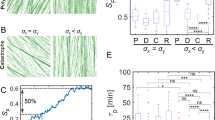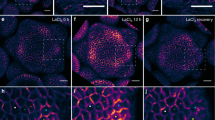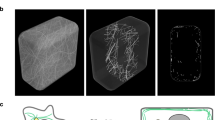Summary
Changes in the orientation of cortical microtubules (longitudinal vs. transverse with respect to the long cell axis) at the outer epidermal wall of maize coleoptile segments were induced by auxin, red or blue light, and mechanical stresses (cell extension or compression produced by bending). Immunofluorescent techniques were used for the quantitative determination of frequency distributions of microtubule orientation. Detailed kinetic studies showed that microtubule reorientations are temporally correlated with the simultaneously measured changes in growth rate elicited by auxin, red light, or blue light. Growth inhibition induced by depletion of endogenous auxin produces a longitudinal microtubule pattern that can be changed into a transverse pattern in a dose-dependent manner by applying exogenous auxin. A mid-point pattern with equal frequencies of longitudinal and transverse microtubules was adjusted at 2 μmol/1 auxin. Bending stress applied under these conditions adjusts permanent, maximally longitudinal and transverse microtubule orientations at the compressed and extended segment sides, respectively, quantitatively mimicking the responses to differential flank growth during phototropic and gravitropic curvature. During tropic curvature the changes in microtubule pattern reflect the distribution of growth rather than the distribution of auxin. The microtubule pattern responds to auxin-dependent growth changes and mechanical stress in a synergistic manner, confirming the functional equivalence of these factors in affecting microtubule orientation. Similar results were obtained when segment growth was altered by blue or red light instead of auxin in the presence or absence of mechanical stress. It is concluded from these results that growth changes, elicited by auxin, light, etc., and mechanical stress affect microtubule orientation through a common signal perception and transduction chain.
Similar content being viewed by others
Abbreviations
- IAA:
-
indole-3-acetic acid (auxin)
- MT:
-
cortical microtubule
References
Akashi T, Shibaoka H (1987) Effect of gibberellin on the arrangement and cold stability of cortical microtubules in epidermal cells of pea internodes. Plant Cell Physiol 28: 339–348
Baluska F, Parker JS, Barlow PW (1993) A role of gibberellic acid in orienting microtubules and regulating cell growth polarity in maize root cortex. Planta 191: 149–157
Bergfeld R, Speth V, Schopfer P (1988) Reorientation of microfibrils and microtubules at the outer epidermal wall of maize coleoptiles during auxin-mediated growth. Bot Acta 101: 57–67
Blackman LM, Overall RL (1995) Electrical fields affect the orientation of cortical microtubules and cell expansion in pea callus. Protoplasma 189: 256–266
Blancaflor EB, Hasenstein KH (1995) Time course and auxin sensitivity of cortical microtubule reorientation in maize roots. Protoplasma 185: 72–82
Hogetsu T, Oshima Y (1986) Immunofluorescence microscopy of microtubule arrangement in root cells ofPisum sativum L. var. Alaska. Plant Cell Physiol 27: 939–945
Ishida K, Katsumi M (1991) Immunofluorescence microscopical observation of cortical microtubule arrangement as affected by gibberellin in d5 mutant ofZea mays L. Plant Cell Physiol 32: 409–417
— — (1992) Effects of gibberellin and abscisic acid on the cortical microtubule orientation in hypocotyls of light-grown cucumber seedlings. Int J Plant Sci 153: 155–163
Iwata K, Hogetsu T (1989) The effects of light irradiation on the orientation of microtubules in seedlings ofAvena sativa L. andPisum sativum L. Plant Cell Physiol 30: 1011–1016
Kaneta T, Kakimoto T, Shibaoka H (1993) Actinomycin D inhibits the GA3-induced elongation of azuki bean epicotyls and the reorientation of cortical microtubules. Plant Cell Physiol 34: 1125–1132
Kutschera U, Schopfer P (1985) Evidence against the acid-growth theory of auxin action. Planta 163: 483–493
Laskowski MJ (1990) Microtubule orientation in pea stem cells: a change in orientation follows the initiation of growth rate decline. Planta 181: 44–52
Mayumi K, Shibaoka H (1995) A possible double role for brassinolide in the reorientation of cortical microtubules in the epidermal cells of azuki bean epicotyls. Plant Cell Physiol 36: 173–181
Mita T, Katsumi M (1986) Gibberellin control of microtubule arrangement in the mesocotyl epidermal cells of the d5 mutant ofZea mays L. Plant Cell Physiol 27: 651–659
—, Shibaoka H (1984a) Gibberellin stabilizes microtubules in onion leaf sheath cells. Protoplasma 119: 100–109
— — (1984b) Effects of S-3307, an inhibitor of gibberellin biosynthesis, on swelling of leaf sheath cells and on the arrangement of cortical microtubules in onion seedlings. Plant Cell Physiol 25: 1531–1539
Mizuno K (1994) Inhibition of gibberellin-induced elongation, reorientation of cortical microtubules and change of isoform of tubulin in epicotyl segments of azuki bean by protein kinase inhibitors. Plant Cell Physiol 35: 1149–1157
Mohr H (1966) Untersuchungen zur phytochrominduzierten Photomorphogenese des Senfkeimlings (Sinapis alba L.). Z Pflanzenphysiol 54: 63–83
Nick P, Bergfeld R, Schäfer E, Schopfer P (1990) Unilateral reorientation of microtubules at the outer epidermal wall during photo and gravitropic curvature of maize coleoptiles and sunflower hypocotyls. Planta 181: 162–168
—, Furuya M, Schäfer E (1991) Do microtubules control growth in tropism? Experiments with maize coleoptiles. Plant Cell Physiol 32: 999–1006
—, Schäfer E, Furuya M (1992) Auxin redistribution during first positive phototropism in corn coleoptiles. Microtubule reorientation and the Cholodny-Went theory. Plant Physiol 99: 1302–1308
Roberts IN, Lloyd CW, Roberts K (1985) Ethylene-induced microtubule reorientations: mediation by helical arrays. Planta 164: 439–447
Sakiyama M, Shibaoka H (1990) Effects of abscisic acid on the orientation and cold stability of cortical microtubules in epicotyl cells of the dwarf pea. Protoplasma 157: 165–171
Sakiyama-Sogo M, Shibaoka H (1993) Gibberellin A3 and abscisic acid cause the reorientation of cortical microtubules in epicotyl cells of the decapitated dwarf pea. Plant Cell Physiol 34: 431–427
Sakoda M, Hasegawa K, Ishizuka K (1992) Mode of action of natural growth inhibitors in radish hypocotyl elongation — influence of raphanusanin on auxin-mediated microtubule orientation. Physiol Plant 84: 509–513
Sauter M, Seagull RW, Kende H (1993) Internodal elongation and orientation of cellulose microfibrils and microtubules in deep-water rice. Planta 190: 354–362
Shibaoka H (1974) Involvement of wall microtubules in gibberellin promotion and kinetin inhibition of stem elongation. Plant Cell Physiol 15: 255–263
— (1994) Plant hormone-induced changes in the orientation of cortical microtubules: alterations in the cross-linking between microtubules and the plasma membrane. Annu Rev Plant Physiol Plant Mol Biol 45: 527–544
Sylvester AW, Williams MH, Green PB (1989) Orientation of cortical microtubules correlates with cell shape and division direction. Immunofluorescence of intact epidermis during development ofGraptopetalum paraguayensis. Protoplasma 153: 91–103
Toyomasu T, Yamane H, Murofushi N, Nick P (1994) Phytochrome inhibits the effectiveness of gibberellins to induce cell elongation in rice. Planta 194: 256–263
Zandomeni K, Schopfer P (1993) Reorientation of microtubules at the outer epidermal wall of maize coleoptiles by phytochrome, blue-light photoreceptor and auxin. Protoplasma 173: 103–112
— — (1994) Mechanosensory microtubule reorientation in the epidermis of maize coleoptiles subjected to bending stress. Protoplasma 182: 96–101
Author information
Authors and Affiliations
Rights and permissions
About this article
Cite this article
Fischer, K., Schopfer, P. Interaction of auxin, light, and mechanical stress in orienting microtubules in relation to tropic curvature in the epidermis of maize coleoptiles. Protoplasma 196, 108–116 (1997). https://doi.org/10.1007/BF01281064
Received:
Accepted:
Issue Date:
DOI: https://doi.org/10.1007/BF01281064




